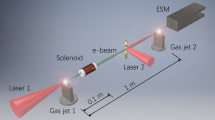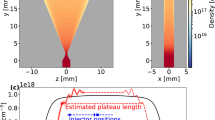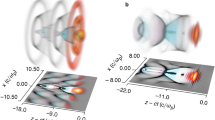Abstract
Plasma-based acceleration offers compact accelerators with potential applications for high-energy physics and photon sources. The past five years have seen an explosion of experimental results with monoenergetic electron beams up to 1 GeV on a centimetre-scale, using plasma waves driven by intense lasers. The next decade will see tremendous increases in laser power and energy, permitting beam energies beyond 10 GeV. Leveraging on the Lorentz transformations to bring the laser and plasma spatial scales together, we have reduced the computational time for modelling laser–plasma accelerators by several orders of magnitude, including all the relevant physics. This scheme enables the first one-to-one particle-in-cell simulations of the next generation of accelerators at the energy frontier. Our results demonstrate that, for a given laser energy, choices in laser and plasma parameters strongly affect the output electron beam energy, charge and quality, and that all of these parameters can be optimized.
This is a preview of subscription content, access via your institution
Access options
Subscribe to this journal
Receive 12 print issues and online access
$209.00 per year
only $17.42 per issue
Buy this article
- Purchase on Springer Link
- Instant access to full article PDF
Prices may be subject to local taxes which are calculated during checkout




Similar content being viewed by others
References
Tajima, T. & Dawson, J. M. Laser electron accelerator. Phys. Rev. Lett. 43, 267–270 (1979).
Geddes, C. G. R. et al. High-quality electron beams from a laser wakefield accelerator using plasma-channel guiding. Nature 431, 538–541 (2004).
Faure, J. et al. A laser–plasma accelerator producing monoenergetic electron beams. Nature 431, 541–544 (2004).
Mangles, S. P. D. et al. Monoenergetic beams of relativistic electrons from intense laser–plasma interactions. Nature 431, 535–538 (2004).
Leemans, W. P. GeV electron beams from a centimetre-scale accelerator. Nature Phys. 2, 696–699 (2006).
Rosenzweig, J. B., Breizman, B., Katsouleas, T. & Su, J. J. Acceleration and focusing of electrons in two-dimensional nonlinear plasma wake fields. Phys. Rev. A 44, R6189–R6192 (1991).
Lu, W. et al. Nonlinear theory for relativistic plasma wakefields in the blowout regime. Phys. Rev. Lett. 96, 165002 (2006).
Pukhov, A. & Meyer-ter-Vehn, J. Laser wake field acceleration: The highly non-linear broken-wave regime. Appl. Phys. B 74, 355–361 (2002).
Gordienko, S. & Pukhov, A. Scalings for ultrarelativistic laser plasmas and quasimonoenergetic electrons. Phys. Plasmas 12, 043109 (2005).
Lu, W. et al. Generating multi-GeV electron bunches using single laser wakefield acceleration in a 3D nonlinear regime. Phys. Rev. Spec. Top. 10, 061301 (2007).
Tzoufras, M. et al. Beam loading in the nonlinear regime of plasma-based acceleration. Phys. Rev. Lett. 101, 145002 (2008).
Norreys, P. A. Laser-driven particle acceleration. Nature Photon. 3, 423–425 (2009).
Tsung, F. et al. Near-GeV-energy laser-wakefield acceleration of self-injected electrons in a centimetre-scale plasma channel. Phys. Rev. Lett. 93, 185002 (2004).
Mangles, S. et al. On the stability of laser wakefield electron accelerators in the monoenergetic regime. Phys. Plasmas 14, 056702 (2007).
Esarey, E., Hubbard, R. F., Leemans, W. P., Ting, A. & Sprangle, P. Electron injection into plasma wakefields by colliding laser pulses. Phys. Rev. Lett. 79, 2682–2685 (1997).
Faure, J. et al. Controlled injection and acceleration of electrons in plasma wakefields by colliding laser pulses. Nature 444, 737–739 (2006).
Bulanov, S., Naumova, N., Pegoraro, F. & Sakai, J. Particle injection into the wave acceleration phase due to nonlinear wake wave breaking. Phys. Rev. E 58, R5257–R5260 (1998).
Geddes, C. G. R. et al. Plasma-density-gradient injection of low absolute-momentum-spread electron bunches. Phys. Rev. Lett. 100, 215004 (2008).
Vay, J.-L. Noninvariance of space- and time-scale ranges under a Lorentz transformation and the implications for the study of relativistic interactions. Phys. Rev. Lett. 98, 130405 (2007).
Schlenvoigt, H.-P. et al. A compact synchrotron radiation source driven by a laser–plasma wakefield accelerator. Nature Phys. 4, 130–133 (2008).
Huang, C. et al. QuickPIC: A highly efficient PIC code for modelling wakefield acceleration in plasmas. J. Comput. Phys. 217, 658–679 (2006).
Tzoufras, M. Generation of Multi-Giga-Electron-Volt Monoenergetic Electron Beams via Laser Wakefield Acceleration PhD thesis, Univ. California (2008).
Fonseca, R. A. et al. in OSIRIS: A 3D, Fully Relativistic Particle in Cell Code for Modeling Plasma Based Accelerators (eds Sloot, P. M. A. et al.) 342–351 (ICCS 2002, LNCS 2331, 2002).
Mangles, S. et al. Laser-wakefield acceleration of monoenergetic electron beams in the first plasma-wave period. Phys. Rev. Lett. 96, 215001 (2006).
Martins, S. F. et al. Numerical simulations of laser wakefield accelerators in optimal Lorentz frames. Comput. Phys. Commun. (in the press).
Martins, S. F. et al. Third US–Japan Workshop on Ultra-Intense Laser Plasma Interactions, November 23–24, Austin, Texas (2008).
Greenwood, A. D. et al. On the elimination of numerical Cerenkov radiation in PIC simulations. J. Comput. Phys. 201, 665–684 (2004).
Esirkepov, T. Exact charge conservation scheme for particle-in-cell simulation with an arbitrary form-factor. Comput. Phys. Commun. 135, 144–153 (2001).
Vay, J.-L. Simulation of beams or plasmas crossing at relativistic velocity. Phys. Plasmas 15, 056701 (2008).
Acknowledgements
This work was partially supported by Fundação Calouste Gulbenkian, by Fundação para a Ciência e a Tecnologia, under grants PTDC/FIS/66823/2006 and SFRH/BD/35749/2007 (Portugal), Laserlab-Europe/LAPTECH, EC FP7 Contract No. 228334, by the US Department of Energy (DOE) under grant numbers DE-FC02-07ER41500, DE-FG02-92ER40727 and DE-FG52-09NA29552, by the NSF under grant numbers PHY-0904039 and PHY 0936266 and by the University of California Lab Research Program. S.F.M. and L.O.S. would like to thank KITP, where a part of this research was concluded, partially supported by the National Science Foundation under Grant number PHY05-51164. We thank the DEISA Consortium (www.deisa.eu), co-funded through the EU FP6 project RI-031513 and the FP7 project RI-222919, for support within the DEISA Extreme Computing Initiative. The simulations presented here were produced using IST Cluster (IST/Portugal), Dawson cluster (UCLA), Jügene (Jülich, Germany) and NERSC supercomputers.
Author information
Authors and Affiliations
Contributions
S.F.M., code development, simulations, data analysis and manuscript preparation; R.A.F., code development; W.L., data analysis; W.B.M. and L.O.S., result analysis and manuscript writing.
Corresponding author
Ethics declarations
Competing interests
The authors declare no competing financial interests.
Rights and permissions
About this article
Cite this article
Martins, S., Fonseca, R., Lu, W. et al. Exploring laser-wakefield-accelerator regimes for near-term lasers using particle-in-cell simulation in Lorentz-boosted frames. Nature Phys 6, 311–316 (2010). https://doi.org/10.1038/nphys1538
Received:
Accepted:
Published:
Issue Date:
DOI: https://doi.org/10.1038/nphys1538
This article is cited by
-
Non-linear QED approach for betatron radiation in a laser wakefield accelerator
Scientific Reports (2024)
-
High-throughput injection–acceleration of electron bunches from a linear accelerator to a laser wakefield accelerator
Nature Physics (2021)
-
Strong field physics pursued with petawatt lasers
AAPPS Bulletin (2021)
-
All optical dual stage laser wakefield acceleration driven by two-color laser pulses
Scientific Reports (2018)
-
Multi-GeV electron-positron beam generation from laser-electron scattering
Scientific Reports (2018)



